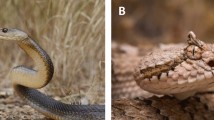Summary
-
1.
Twitches produced by stimulation of the nerve leading to the pharyngeal retractor muscle (PRM) relax more rapidly after a tetanic stimulation.
-
2.
Perfusion of the PRM with 5-hydroxytryptamine (5-HT) mimics this relaxing action. 5-HT is the only factor present in the PRM that causes an increase in twitch relaxation rate. When the 5-HT content of the PRM is reduced by pre-treatment with reserpine, the magnitude of the post-tetanic increase in relaxation rate is also reduced.
-
3.
The post-tetanic increase in relaxation rate appears to require the activation of a specific serotonergic axon(s) since there is a discrete threshold for the effect.
-
4.
Peptides derived from nervous and other tissues of the snail also modulate PRM activity.
-
5.
One peptide (SCP) mimics the action of 5-HT, but is not present in the PRM.
-
6.
A second peptide class (LCP), at concentrations similar to those found in the hemolymph, potentiates the amplitude of sub-maximal contractions of the PRM.
-
7.
It was concluded that 5-HT and LCP are physiological modulators of PRM activity, while the significance of SCP's action is unknown.
Similar content being viewed by others
Abbreviations
- ACh :
-
acetylcholine
- ABRM :
-
anterior byssus retractor muscle
- CNS :
-
central nervous system
- 5-HT :
-
5-hydroxytryptamine
- LCP :
-
large cardioactive peptides
- PRM :
-
pharyngeal retractor muscle
- SCP :
-
small cardioactive peptide
References
Abbott, B.C., Lowy, J.: Contraction in molluscan smooth muscle. J. Physiol.141, 385–397 (1958a)
Abbott, B.C., Lowry, J.: Mechanical properties ofHelix andMytilus muscle. J. Physiol.141, 398–407 (1958b)
Cottrell, G.A.: Amines in molluscan nervous tissue and their subcellular localization. Symp. Neurobiol. Invert., pp. 353–363. Budapest: Akadémiai Kiadó 1967`
Cottrell, G.A., Laverack, M.S.L.: Invertebrate pharmacology. Annu. Rev. Pharmacol.8, 273–298 (1968)
Dale, B.: Blood pressure and its hydraulic functions inHelix pomatia L. J. Exp. Biol.59, 477–490 (1973)
Gerschenfeld, H.M.: Chemical transmission in invertebrate central nervous system and neuromuscular junctions. Physiol. Rev.53, 1–119 (1973)
Kerkut, G.A., Cottrell, G.A.: Pharmacology of the pharyngeal retractor muscle of the snail,Helix aspersa. Life Sci.6, 229–231 (1962)
Kerkut, G.A., Meech, R.W.: The internal chloride concentration of the H and D cells in the snail brain. Comp. Biochem. Physiol.19, 819–832 (1966)
Kerkut, G.A., Leake, L.D., Shapira, A., Cowan, S., Walker, R.J.: The presence of glutamate in nerve-muscle perfusates ofHelix, Carcinus, andPeriplaneta. Comp. Biochem. Physiol.15, 484–502 (1965)
Kerkut, G.A., Shapira, A., Walker, R.J.: The transport of14Clabelled material from the CNS⇋ muscle along a nerve trunk. Comp. Biochem. Physiol.23, 729–748 (1967)
Lloyd, P.E.: Distribution and molecular characteristics of cardioactive peptides in the snail,Helix aspersa. J. Comp. Physiol.128, 269–276 (1978a)
Lloyd, P.E.: Neurohormonal control of cardiac activity in the snail,Helix aspersa. J. Comp. Physiol.128, 277–283 (1978b)
Lloyd, P.E.: Central peptide-containing neurons modulate gut activity inTritonia. Soc. Neurosci. Abstr.5, 252 (1979)
Lloyd, P.E.: Biochemical and pharmacological analyses of endogenous cardioactive peptides in the snail,Helix aspersa. J. Comp. Physiol.138, 265–270 (1980a)
Lloyd, P.E.: Mechanisms of action of 5-hydroxytryptamine and endogenous peptides on a neuromuscular preparation in the snail,Helix aspersa. J. Comp. Physiol.139, 341–347 (1980b)
Ozeki, M.: Electrical and mechanical activities of the retractor pharynx muscle of a snail. Jpn. J. Physiol.12, 293–311 (1962)
Ramsay, J.A.: A nerve-muscle preparation from the snail. J. Physiol. (London)17, 96–115 (1940)
Rose, R.M., Benjamin, P.R.: The relationship of the central motor patterns to the feeding cycles ofLymnea stagnalis. J. Exp. Biol.80, 137–164 (1979)
Sato, M., Tamasige, M., Ozeki, M.: Electrical activity of the retractor pharynx muscle of the snail. Jpn. J. Physiol.10, 85–98 (1960)
Twarog, B.M., Muneoka, Y.: Calcium and the control of contraction and relaxation in a molluscan catch muscle. Cold Spring Harbor Symp. Quant. Biol.37, 489–504 (1973)
Weiss, K.R., Kupfermann, I.: Serotonergic neuronal activity and arousal of feeding inAplysia californica. In: Aspects of behavioral neurobiology. Soc. Neurosci. Symp. Vol. III. Ferrendelli, J.A. (ed.), pp. 66–89. Bethesda, MD: Soc. Neurosci. 1977
Weiss. K.R., Cohen, J.L., Kupfermann, I.: Modulatory control of buccal musculature by a serotonergic neuron (metacerebral cell) inAplysia. J. Neurophysiol.41, 181–205 (1978)
Author information
Authors and Affiliations
Additional information
It wish to thank Drs. I. Deyrup-Olsen, J.W. Truman, and A.O.D. Willows for critical reading of the manuscript. The research was supported by NSF BNS-7906280.
Rights and permissions
About this article
Cite this article
Lloyd, P.E. Modulation of neuromuscular activity by 5-hydroxytryptamine and endogenous peptides in the snail,Helix aspersa . J. Comp. Physiol. 139, 333–339 (1980). https://doi.org/10.1007/BF00610463
Accepted:
Issue Date:
DOI: https://doi.org/10.1007/BF00610463




